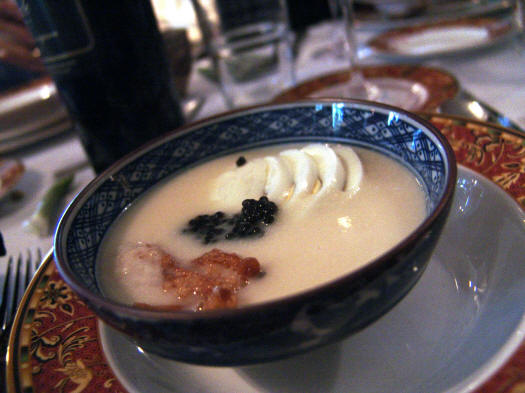Home |
Restaurants by City
|
Food Photography |
Archive | Philosophy |
![]()
Right now we are eating in Seattle, Washington.
|
Tuesday
2005
Permalink
|
White Asparagus Velouté with Eggs and Enoki, tasted on April 24, 2005 — Sorry for the few days between postings, but we've been busy cooking for the most recent Jewish holiday - Passover. Think of it as a kind of Jewish Thanksgiving. Lots of food, and four mandatory cups of wine. Yes. Mandatory. I've already documented our efforts from a couple of years ago. This year we decided to do fewer courses and do them even better. Focus focus focus. We thought we would follow our own advice we regularly dole out to restaurants. The menu consisted of: chicken soup with matzah balls (I'll write a full report on this later), homemade gefilte fish (again, I'll have to write up this report later), eggplant, purple yam, and garlic terrine, and Lampreia Coconut Cookies among other things. But there was one dish I'd like to focus on today. At our Passover meals it's tradition to start off the eating portion of the event with a small bowl of saltwater with a sliced hard-boiled egg. This year I decided to do something different. I still wanted to retain the essence of the dish, the saltwater being tear-like and intended to evoke sadness. But I wanted something more interesting. Instead this year I made White Asparagus Veloute with Egg, Enoki Mushroom Tempura and American Caviar. (Note: for anyone really up on the rules of kosher food. Some Jewish sources consider Sturgeon not kosher. But some Conservative sources say it is. If you are keeping kosher, and won't eat caviar from sturgeon, feel free to replace with eggs from a fish that you will eat. Or even capers.) The caviar is there for the salt. The white asparagus and tempura'd enoki mushrooms make for a sea of softer tones with the egg.
Here's the recipe:
I had slightly different plans for this dish as I was hoping to cook the eggs so the whites were cooked but the yolks were soft and warm. That way when you put your spoon into the egg, the yolk would leak out into the asparagus velouté. I also had fantasies of cooking the eggs in containers that would make them into cool shapes, but I'm not sure these even exist. Is there such a thing as a plastic cube or pyramid or other shape that you can fill with egg, seal, and then hard boil, only later to release the egg in its cool shape? If that does exist, please tell me. If not, then I expect royalty payments. A couple of things to wrap-up. This seemed like a big hit at our meal. Jenny in particular enjoyed it. Additionally, I basically ripped off the Velouté formula from the red cabbage veloute in All About Apples. And finally, it doesn't need to be Passover, and you don't need to be Jewish to enjoy this. I think it's quite good any time for anyone.
|
|
Our Sponsors
Free Car Listings – Hot Tubs – Stools – Saunas – Bar Stools - Calendar and Event Schedules - Food Events and Calendars - Wine Events and Calendars - Digital Photography Resources - Software for Advertisers - Jewish Gifts and Judaica - Howard Stern Podcast - ponytailed blogger Jonathan Schwartz

Browse tastingmenu
Home |
Restaurants by City X |
Food Photography |
Archive | Philosophy |
![]()
Free eBooks: All About Apples
| Autumn Omakase
More:
Discussion |
Cool Food T-Shirts |
Ingredients
| Markets |
Recipes
Search |
Blog FAQ |
Other
Blogs
Best of tastingmenu
|
City View
Entry: July 6, 2006 |
Blue Plate
Entry: June 19, 2006 |
L'Atelier de Joël Robuchon
Entry: July 18, 2006 |
Browse by City
Boston | Chicago | Houston | Las Vegas | Los Angeles | Maui | New York | Philadelphia | Portland | San Francisco | Seattle | Toronto | Utah | Vancouver | Washington D.C.
Bangkok | Beijing | Hong Kong | Seoul | Tokyo
Amsterdam | Berlin | Italy | London | Madrid | Paris | Vienna
Browse by Month
2006
2005
2004
2003
2002
2001
Comments, questions, or feedback:
info / at / tastingmenu / dot / com
All pages Copyright (c) 2001-2006 tastingmenu.com
Last modified 01/30/07.




